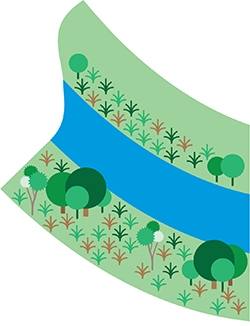Planning for climate change and flooding
The Township Flood Challenge game focuses on river flooding, which can be caused by tropical cyclones, prolonged or intense rainfall or, occasionally, severe thunderstorms.
Types of flooding
There are three types of flooding – river (fluvial) floods; intense rainfall/flash floods (pluvial); and coastal floods/storm surge.
River flooding can even happen on a fine day if enough rain falls in the headwaters of a river.
Understanding and planning for increasing flooding
To understanding why river floods happen, we can look at historical data as well as future flood modelling.
Extreme weather and flooding are expected to increase in frequency and severity due to climate change. Understanding flooding and its impacts is important as it allows us to plan ahead and be ready when it does occur.
Adaptation choices
When playing and discussing the Township Flood Challenge Game, we are focussing on adapting to the impacts of river flooding. Although there are similarities when adapting to the impacts to all types of floods, there are also some subtle differences. For more information about coastal floods and adaptation options, please refer to Climate change adaptation – My Coastal Futures.
'Ko au te awa, ko te awa ko au' – rivers are part of whakapapa to tangata whenua Māori
Rivers are an important part of our lives - economically, socially, culturally and environmentally. Many New Zealanders are currently at risk of river or surface flooding. For many of us, rivers are:
- a source of food
- a highway
- a place of play and recreation• a source of hydro-electric energy
- a source of water to irrigate our farms
- natural environments that can bring us spiritual connection and a sense of peace and wellbeing.
| ACTIVITY: Watch 'Mā te haumaru ō ngā puna wai ō Rākaihautū ka ora mō ake tonu: Increasing flood resilience across Aotearoa’ (2 min 50 s) Vision Mātauranga is at the heart of this research programme. The researchers are working with the hapū of Wairewa Rūnanga, Kāti Mako and Ngāti Irakehu, to explore their knowledge of flooding and to develop a plan to enhance the sustainability of their taonga. The programme outputs will also feed into the development of the Wairewa Rūnanga climate change strategy. The knowledge developed here will provide a template for other hapū and iwi to use to understand their flood risk. |
Fluvial floods: What are the options?
There are a number of options available to protect people, structures and the environment from flooding in the Township Flood Challenge game. Below provides a brief overview of each.
Redesign e.g. raise house

Adapting existing assets for hazards e.g. raising floor levels to reduce flooding.
Advantages
Retrofitting (adding or changing something after it is first built) is often less expensive than replacing, and can cause less disruption than relocating.
Disadvantages
Cost to implement. During an event you may be stranded e.g. isolated in a raised house surronded by flood waters. You may also suffer damage to infrastructure e.g. pipes and have repair costs.
Limits
Redesign options are often not permanent solutions.
Relocate

Moving away from a hazard source permanently e.g. move buildings/infrastructure, sell, and move to area with less hazards.
Advantages
Relocating people, buildings and infrastructure such as roads or water pipes away from the river and/or to higher elevations means they are no longer impacted by flooding. Relocation of communities also provides opportunities to improve how a town functions e.g. adding new parks and playgrounds or creating new town centres with additional facilities that are easier to walk around.
Disadvantages
Relocation is usually disruptive because it involves re-organising the community and moving homes, business, roads, community assets and infrastructure.
Relocation costs can be very high. People may have cultural connections to a place (e.g. wāhi tapu or sacred places) which may make relocation very distressing.
Limits
None. Well-planned relocation is a permanent/long term solution to the hazards of climate change.
Nature-based solution

The farmer and kaumātua can choose to implement a nature-based solution. Both must agree. This involves them planting a new wetland area in front of their properties to retain flood water and reduce flood risk. This will cost them a combined $1.65 million! They need to move buildings on their property back and then do planting and contouring.
Advantages
The advantages of a nature-based solution are that the riverside houses in town are safe from a ‘high flood’, although not from a ‘severe flood’. Just like a stopbank the townsfolk get the advantage, but at no cost to themselves; the costs sit with the farm and marae. Townsfolk are prompted in the game to donate money to help with this cost though. The farm arguably gains some advantage, in that they get income security. So, because the wetland takes up some of their productive land, their annual income drops to $400,000. However, it also means that if there’s a flood, their land is not further damaged. So, even in a ‘severe flood’, they still get $400,000, instead of $300,000. And of course, there is the potential benefit gained from restoring the land, having a beautiful wetland, the return of native bird species and so on. It's also very good for biodiversity and provides habitat for native animals.
Disadvantages The disadvantage of a nature-based solution is that the marae and farm need to provide land and move buildings in order to make room for the river to flood. It is also expensive to maintain. Although the options will work well the cost of $1.65 million falls on two players. Is this fair?
Limits
Climate may change enough that these habitats will no longer thrive in your area.
Stopbank

An earth embankment built to contain rivers and streams in flood. Stopbanks protect many Aotearoa New Zealand towns, cities and farmland from floodwater damage.
Advantages
A stopbank will keep a flooded waterway away from the assets being protected (housing, roading, farmland etc.)
Disadvantages
Stopbanks are only as strong as their weakest point so protecting them from damage is vital. Regular checks and maintenance need to be budgeted for. If a stopbank fails or is overtopped there is a high risk of major flooding damage. Stopbanks are a barrier to access and views of waterways and can reduce connectivity between the waterway and other ecosystems like wetlands.
Limits
An increasing frequency and level of flooding puts pressure on the stopbank. Maintenance and repair could eventually become unaffordable or ineffective.
| ACTIVITY: Adaptation options - pros, cons and wellbeing A useful way to frame a discussion on adaptation is to think about the four fundamental components of community wellbeing that help communities articulate and realise the things that matter most to them:
Share each of the flood game adaptation options with the ākonga. In groups, ask each to choose one adaptation option and brainstorm the advantages and disadvantages of each guided by the four wellbeings. Each group then shares, while the other groups provide feedback and ideas that may not have been mentioned. Using the information above under Fluvial floods: What are the options?, ask each group to research their chosen adaptation option reflecting on the following:-
EXTRA: As kaiako and ākonga play and discuss the Township Flood Challenge game, you may find NIWA's Climate Change Adaptation Toolbox helpful. It provides general information about the changing climate, what it might mean for your school or community and what you can do about it. You can assess your current climate resilience and plan for future change by working through five steps. |
Next: Learning support #3: Climate change and floods - values, perspectives and decision-making
